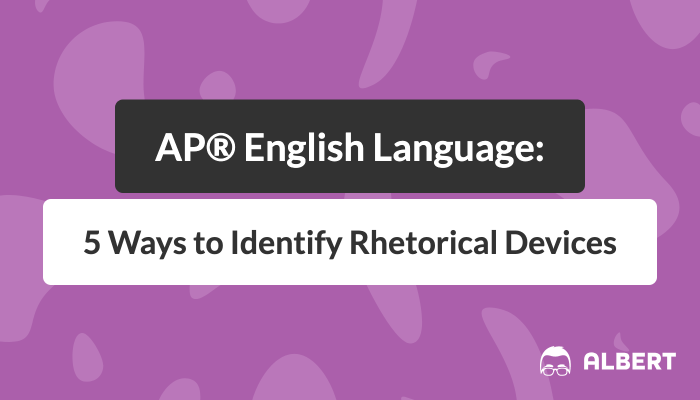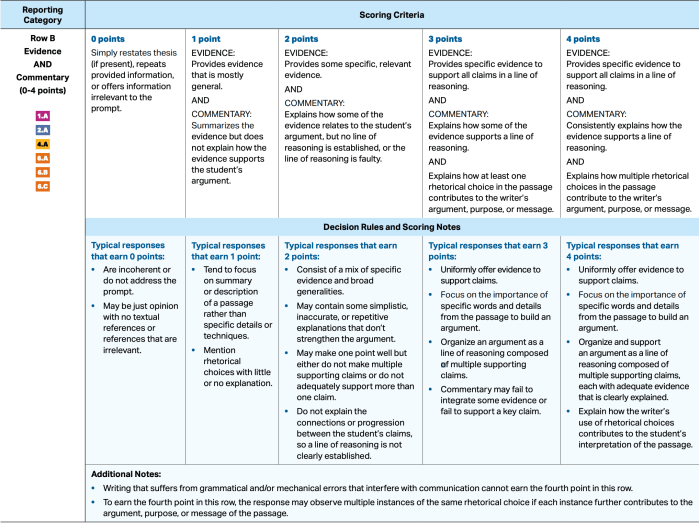Rhetorical devices in AP Lang ignite a passion for language and its power to persuade, analyze, and create. From the iconic speeches of history to the pages of great literature, these literary tools elevate expression, making your writing and analysis soar.
Throughout this comprehensive guide, we’ll delve into the arsenal of rhetorical devices, exploring their purpose, effectiveness, and application. Whether you’re navigating the complexities of AP Lang exams or seeking to enhance your writing skills, this exploration will empower you to harness the art of rhetoric.
Types of Rhetorical Devices in AP Lang

Rhetorical devices are literary techniques used to enhance the effectiveness of communication. They can be used to persuade, inform, or entertain an audience. In AP Lang, students are expected to be familiar with a variety of rhetorical devices.
Types of Rhetorical Devices
- Anaphora: The repetition of a word or phrase at the beginning of successive clauses or sentences.
- Purpose: To create emphasis and build momentum.
- Example: “We will not be moved. We will not be defeated. We will not be denied.”
(Martin Luther King, Jr.)
- Antithesis: The juxtaposition of contrasting ideas or words.
- Purpose: To create tension and highlight differences.
- Example: “The world is too small for war, but too large for isolation.” (Dwight D. Eisenhower)
- Hyperbole: An exaggeration for emphasis or effect.
- Purpose: To create a strong impression or evoke emotion.
- Example: “I’m so hungry I could eat a horse.”
- Irony: The use of words to convey a meaning that is the opposite of their literal meaning.
- Purpose: To create humor, satire, or emphasis.
- Example: “It was the best of times, it was the worst of times.” (Charles Dickens, A Tale of Two Cities)
- Metaphor: A comparison between two unlike things that share a common characteristic.
- Purpose: To create vivid imagery and deepen understanding.
- Example: “Life is a journey.”
- Metonymy: The substitution of a closely related word or phrase for another.
- Purpose: To create a more concise or vivid expression.
- Example: “The White House” (referring to the U.S. government)
- Personification: Giving human qualities to nonhuman things.
- Purpose: To create a more vivid or engaging description.
- Example: “The wind whispered through the trees.”
- Simile: A comparison between two unlike things using “like” or “as.”
- Purpose: To create vivid imagery and deepen understanding.
- Example: “He was as brave as a lion.”
- Synecdoche: The use of a part to represent the whole or vice versa.
- Purpose: To create a more concise or vivid expression.
- Example: “All hands on deck” (referring to all crew members)
These are just a few of the many rhetorical devices that students should be familiar with for AP Lang. By using these devices effectively, students can enhance the power and impact of their writing and speaking.
Identifying and Analyzing Rhetorical Devices

Identifying and analyzing rhetorical devices are crucial skills in AP Lang. These techniques help writers effectively convey messages, persuade audiences, and create impactful texts. Understanding how to recognize and interpret rhetorical devices enhances your ability to analyze and appreciate literary works.To
identify rhetorical devices, begin by reading the text carefully and paying attention to the language used. Consider the author’s choice of words, sentence structure, and figurative language. Look for patterns, repetitions, or deviations from the expected that might indicate the use of a rhetorical device.Once
you have identified potential rhetorical devices, analyze their effectiveness. Consider how the device contributes to the overall meaning and tone of the text. Does it enhance the writer’s argument? Evoke emotions? Create a particular atmosphere? Understanding the purpose and impact of rhetorical devices deepens your understanding of the text.Context
plays a vital role in interpreting rhetorical devices. The meaning and effectiveness of a device can vary depending on the genre, audience, and historical context of the text. Consider the author’s purpose, the intended audience, and the cultural or historical background of the work to fully grasp the significance of rhetorical devices.
Strategies for Identifying Rhetorical Devices
-
-*Look for patterns and repetitions
Writers often use repetition, parallelism, or contrast to emphasize ideas or create rhythm.
-*Analyze sentence structure
Unusual sentence structures, such as inversion, fragmentation, or asyndeton, can indicate the use of rhetorical devices.
-*Pay attention to figurative language
Metaphors, similes, personification, and other figures of speech are common rhetorical devices that enhance imagery and create deeper meanings.
Analyzing the Effectiveness of Rhetorical Devices
-
-*Consider the purpose
Determine whether the device strengthens the argument, evokes emotions, or creates a specific atmosphere.
-*Examine the impact on the reader
Analyze how the device influences the reader’s understanding, emotions, or perspective.
-*Evaluate the context
Understand how the device fits within the overall text and how it contributes to the author’s intended message.
The Role of Context in Interpreting Rhetorical Devices
-
-*Genre
Different genres have different conventions for using rhetorical devices.
-*Audience
The intended audience influences the choice and effectiveness of rhetorical devices.
-*Historical context
Cultural and historical factors can shape the meaning and interpretation of rhetorical devices.
By understanding these strategies, you can effectively identify and analyze rhetorical devices in AP Lang, enhancing your ability to appreciate and interpret literary works.
Using Rhetorical Devices in Writing

Incorporating rhetorical devices into your writing can enhance its effectiveness and impact. These literary tools provide a powerful means to engage readers, convey ideas, and evoke emotions.
Crafting Effective Uses of Rhetorical Devices, Rhetorical devices in ap lang
To use rhetorical devices effectively, consider the following guidelines:
- Choose devices that align with your purpose and audience:Select devices that resonate with the tone and message you aim to convey.
- Use devices sparingly:Overuse can diminish their impact and make writing seem forced or artificial.
- Be original and avoid clichés:Opt for fresh and unique expressions to create a lasting impression.
Examples of Effective Uses in Different Writing Types
Rhetorical devices can enhance various types of writing, including:
- Persuasive writing:Use ethos, pathos, and logos to build credibility, appeal to emotions, and provide logical arguments.
- Narrative writing:Employ imagery, metaphors, and similes to create vivid scenes and evoke sensory experiences.
li> Expository writing:Utilize analogies, comparisons, and examples to clarify complex ideas and make them relatable.
Rhetorical Devices in Historical and Contemporary Speeches

Rhetorical devices have been instrumental in shaping the persuasive power of speeches throughout history and continue to play a crucial role in contemporary discourse. By analyzing the use of these devices in famous speeches, we can gain insights into their effectiveness and impact on audiences.
Analyzing Rhetorical Devices in Historical Speeches
Examining historical speeches allows us to trace the evolution of rhetorical devices and their influence on persuasive strategies. For instance, in Martin Luther King Jr.’s “I Have a Dream” speech, the use of repetition, parallelism, and imagery created a powerful emotional impact that resonated with the audience.
In AP Lang, rhetorical devices are essential for analyzing texts. These techniques enhance writing and persuasive speech. Take a break from rhetorical devices and explore unit 8 ap psychology vocab . Return to rhetorical devices to refine your understanding of how language shapes meaning.
Similarly, Abraham Lincoln’s “Gettysburg Address” employed rhetorical devices such as antithesis and metaphor to convey a profound message of unity and reconciliation.
Comparing the Effectiveness of Different Devices in Different Contexts
The effectiveness of rhetorical devices varies depending on the context and purpose of the speech. In persuasive speeches, devices like pathos (emotional appeals) and ethos (credibility) can be particularly influential. In informative speeches, clarity and logical organization are crucial, often achieved through the use of analogies, examples, and statistics.
Impact of Rhetorical Devices on Persuasive Power
Rhetorical devices significantly enhance the persuasive power of speeches by engaging the audience’s emotions, establishing credibility, and structuring arguments effectively. By using these devices strategically, speakers can capture attention, influence opinions, and inspire action. Examples include the use of hyperbole to exaggerate a point, irony to create humor or sarcasm, and rhetorical questions to provoke thought.
Rhetorical Devices in Literature

Rhetorical devices are indispensable tools in the literary toolbox, employed by authors to shape character, advance plot, and illuminate theme. By understanding the interplay between devices and these literary elements, we can unlock the deeper meanings and artistic intentions of literary works.
Characterization
Rhetorical devices play a pivotal role in character development. Through metaphors, similes, and personification, authors can craft vivid and memorable characters. For instance, in Shakespeare’s Romeo and Juliet, Juliet’s description of Romeo as “the sun” not only highlights his radiance but also foreshadows his tragic end.
Plot
Devices also contribute to the unfolding of the plot. Irony and foreshadowing create suspense and tension, while imagery and symbolism provide sensory details that immerse readers in the story. In Emily Dickinson’s poem “Because I could not stop for Death,” the speaker’s personification of Death as a gentleman caller adds an eerie and unexpected twist to the traditional portrayal of death.
Theme
Rhetorical devices can amplify and reinforce the central themes of a literary work. Symbolism, allegory, and juxtaposition can convey abstract concepts and explore complex human emotions. In George Orwell’s Animal Farm, the use of animal characters to represent human political figures satirizes the dangers of totalitarianism.
Quick FAQs
What is the purpose of rhetorical devices?
Rhetorical devices are literary tools employed to enhance the effectiveness and impact of communication. They can persuade, clarify, evoke emotions, and add depth to writing and speech.
How can I identify rhetorical devices in a text?
To identify rhetorical devices, pay attention to language patterns, figurative language, and the overall structure of the text. Look for repetitions, contrasts, emotional appeals, and other techniques that deviate from ordinary speech.
Can rhetorical devices be overused?
While rhetorical devices can enhance writing, overuse can weaken their impact. Use them strategically and sparingly to avoid overwhelming your audience and detracting from your message.
